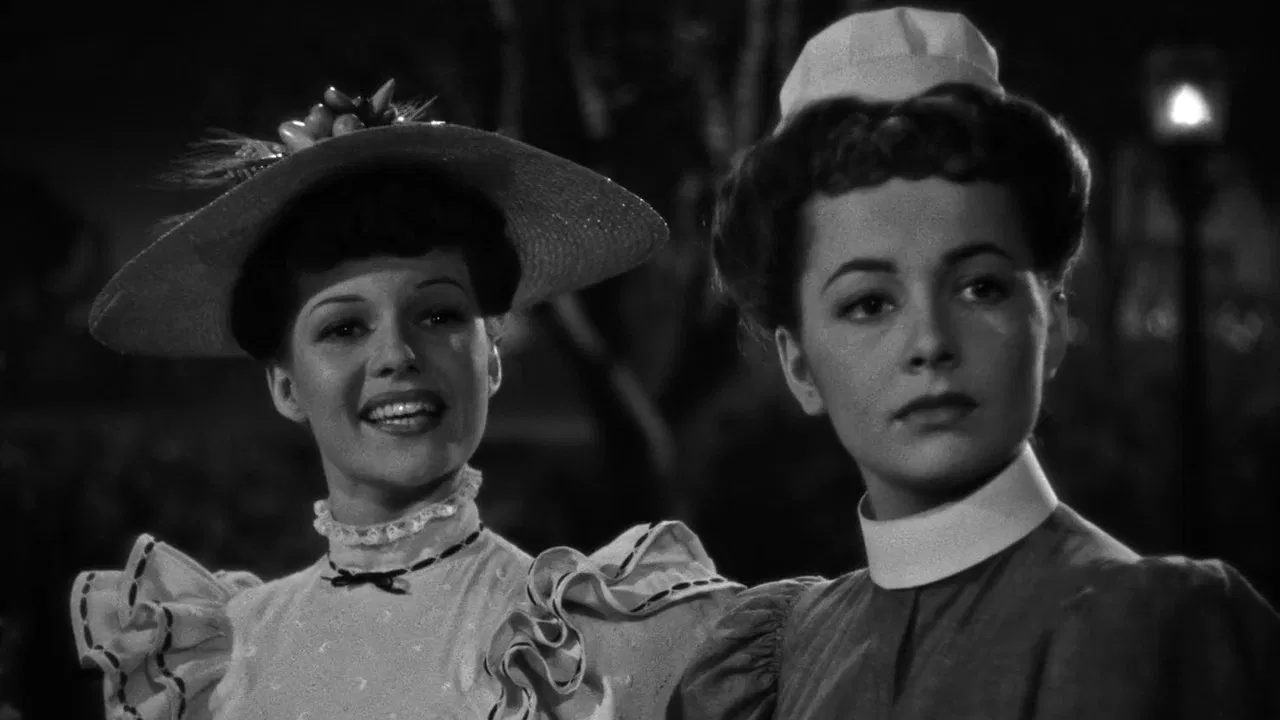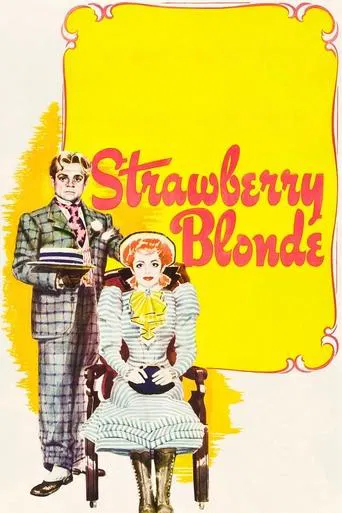Develiker
terrible... so disappointed.
ShangLuda
Admirable film.
Casey Duggan
It’s sentimental, ridiculously long and only occasionally funny
Lela
The tone of this movie is interesting -- the stakes are both dramatic and high, but it's balanced with a lot of fun, tongue and cheek dialogue.
JohnHowardReid
As The Academy of Motion Picture Arts and Sciences wisely categorized, The Strawberry Blonde is actually a musical. True, it could also be aptly described as a romantic comedy or even as a comedy-drama. But with its feast of period songs, I see it primarily as a musical in which both the period nostalgia and even the songs themselves are gently spoofed. Walsh's bright, crisp direction deftly employs a dazzling variety of camera angles and fluid camera movements. These, combined with sharp film editing, effectively disguise the screenplay's otherwise rather obvious stage origins. Walsh also had the supreme advantage of an extremely generous budget which ran to large, lavishly appointed sets that could never be duplicated even in the roomiest Broadway theater. As the volatile, rather bitter dentist, James Cagney seems perfectly cast, while George Tobias (in the Roscoe Karns role) makes an ideal stooge in the opening scenes where so much depends on instant information dialogue. Between them, Cagney and Tobias lay this essential groundwork not only with care, precision and subtlety, but with an unobtrusive professionalism that adds up to sheer entertainment. On the other hand, although Rita Hayworth plays the title role, she makes a rather late entrance. Even Jack Carson, perfectly cast as the obnoxious Hugo "whom we all know and love", precedes her. Fortunately, the ground has now been well prepared. When she finally appears, Rita certainly lives up to her reputation. She's simply great. Our only beef is that we would like to have seen her role extended even further. As the critic for the weekly trade paper, Variety astutely commented: "Rita Hayworth blossoms like a rose. Clothed in stunning period costumes and gorgeously photographed, she gives her role a vivid quality and her personality a showcasing which will enormously increase her importance." My only beef is that the first two-thirds of The Strawberry Blonde where the script's accent lies firmly in the realms of musical comedy, offers superior entertainment to the last third where the action takes a more dramatic turn. Director Raoul Walsh seems unable to decide in what mood to play the final scenes, whereas his confident approach of nostalgic caricature and farce seemed such a perfect choice for Acts One and Two.
SimonJack
"The Strawberry Blonde" is a comedy-romance that takes place in the Gay Nineties, which for most of the American population weren't all that carefree and happy. But this film, and the James Hagan play it was based on, focus more on the daily lives of city dwellers and the mores of that time. The Epstein brothers (Julius and Philip) wrote the screenplay for this 1941 film, no doubt explicitly to fit James Cagney's persona.The title is from a line in the 1895 popular tune, "The Band Played On," by John F. Palmer (lyrics) and Charles B. Ward (music). And the song is a constant prop or background for the movie. We see and hear it sung by a barbershop quartet, played by a marching band, and played by an orchestra at a dance. It takes on an almost haunting presence as we hear it in the background coming from a radio, or from a street band outdoors, or in the park. Indeed, it is inextricably woven into plot.It is a catchy tune and it serves nicely as a thread that ties together the lives of its four main characters. They are Biff Grimes (James Cagney), Amy Lind (Olivia de Havilland), Virginia Brush (Rita Hayworth), and Hugo Barnstead (Jack Carson). A fine supporting cast includes George Tobias, Alan Hale, Una O'Connor, and George Reeves. All performances are excellent.Other reviewers have noted the off-character nature of Cagney's role. Unlike his hard-bitten persona of the crime and gangster movies that made him a star, here Cagney shows a softer side, albeit still brash and rough around the edges. But he's also more real and takes as many punches and defeats as he hands out.Olivia de Havilland has a role in which we can see the diverse range and abilities of this fine actress. She is one of the greatest actresses in emoting with her face – her eyes, mouth and facial expressions. One of the funniest scenes in this film is in the park when Amy feigns a modern attitude with Biff. She winks, gives the look and strikes a rebellious pose – all of this to do about women coming out and kissing a man, smoking cigarettes, etc. Biff is shocked and shows it. I'm chuckling now as I write this with the scene in my mind.Later, after some things have changed, Biff tosses caution to the wind and says he is ready to live such a loose life with her, and Amy is shocked and frightened. They talk it out, and we just enjoy the comedy of how difficult courting must have been when people were proper and decent in the Gay Nineties.Rita Hayworth is the strawberry blonde, Virginia Brush. She is all sweetness, but underneath that façade is a woman whom probably no man will be able to satisfy. Especially Jack Carson as Hugo Barnstead who thinks he was won the prize by marrying her. Hugo epitomizes a type of character that seemed to flourish for a time in Eastern America – the guy who got rich feeding at the public trough and bilking the public in the process. But, he has taken care that he won't pay for his crimes, and Biff becomes his scapegoat. Carson was an excellent actor and had some fine bigger than life supporting roles in his career. This is one of them.The happy ending in all of this is when Biff and Amy marry after he spends a few years in prison for Hugo's graft. He has studied to become a dentist and has set up a practice in his home. He has a chance to get even when Hugo comes to have a tooth pulled, not knowing that Biff is the dentist. After inflicting the usual pain of pulling a tooth without gas, Biff sees that Hugo and Virginia are miserable together. He and Amy were the right match all along, and their happiness was genuine, based on love.This is an entertaining film in which some fine performers display their diverse talents. And, we get a humorous look at a time past with a nostalgic – if not completely accurate, portrayal of the society and mores of that age.
abcj-2
The first time I saw this film, I was so undone by the underhandedness and unfairness, that I swore it off for future viewings. Then it rolled around on TCM's schedule again, and I had forgotten most of the plot. On this viewing, I paid closer attention to every little detail, and I totally changed my mind about this surprising little film. It had little elements of hilarity that I had forgotten or totally missed the first time. Cagney is quite like that in his comedic roles, I've noticed, and De Hvilland is, too.After getting to know James Cagney and Jack Carson a bit better through numerous other films, I began to have a newfound attachment to this film. One main reason is that it just makes better sense when you pay close attention. Once that all happens, you see De Havilland is quite charming and her understated attractiveness totally envelops the cheap tramp ways of the usual bombshell, Rita Hayworth. The only thing that bothers me is the eight years it takes Biff (Cagney) to exact his revenge. Eight years is a long time, but it's a movie and it does fly by! And revenge is exacted. Just as romantic comedies go, there is a very happy ending. The best part is it is totally not formulaic and, therefore, a real surprise. De Havilland and Cagney have one of De Havilland's cutest scenes caught on film as the movie ends. It's a great ending and a surprising little gem made larger and greater by fantastic writing and a superior cast.
jjnxn-1
A lovely film with perfect performances from all four leads. Cagney is at his braggart best in the early going changing and maturing in a real, believable way. Olivia saucy and a bit bold but with a tenderness underneath, one of her best early performances. They share an immensely moving scene in the later part of the film, some of the best acting either ever did. Jack Carson with his oily glad handing charm is a marvelous fit for the mercenary, boorish, contemptible and rather stupid Hugo. But the one who benefited most from this film was Rita Hayworth. She had been slowly working her way up the ladder to this point but taking over the role when Ann Sheridan got into a dispute with her Warner bosses she took it between her teeth and ran with it all the way to A list stardom. Beautiful and flighty and every mans fantasy she is sublime in her single minded pursuit of wealth and position. Witty and wry and looking sensational in the period clothing she also skillfully shows her character's gradual change from coquettish young filly to dissatisfied, hardened shrew. Walsh sets a sprightly tone to the film and moves it forward at an assured pace helped greatly by several members of the Warner stock company especially Alan Hale and George Tobias. Not as well known as it should be this is classic cinema from Hollywood's Golden age.

